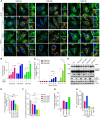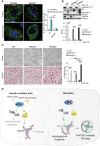Phosphorylation of FAM134C by CK2 controls starvation-induced ER-phagy
- PMID: 36044577
- PMCID: PMC9432840
- DOI: 10.1126/sciadv.abo1215
Phosphorylation of FAM134C by CK2 controls starvation-induced ER-phagy
Abstract
Selective degradation of the endoplasmic reticulum (ER) via autophagy (ER-phagy) is initiated by ER-phagy receptors, which facilitate the incorporation of ER fragments into autophagosomes. FAM134 reticulon family proteins (FAM134A, FAM134B, and FAM134C) are ER-phagy receptors with structural similarities and nonredundant functions. Whether they respond differentially to the stimulation of ER-phagy is unknown. Here, we describe an activation mechanism unique to FAM134C during starvation. In fed conditions, FAM134C is phosphorylated by casein kinase 2 (CK2) at critical residues flanking the LIR domain. Phosphorylation of these residues negatively affects binding affinity to the autophagy proteins LC3. During starvation, mTORC1 inhibition limits FAM134C phosphorylation by CK2, hence promoting receptor activation and ER-phagy. Using a novel tool to study ER-phagy in vivo and FAM134C knockout mice, we demonstrated the physiological relevance of FAM134C phosphorylation during starvation-induced ER-phagy in liver lipid metabolism. These data provide a mechanistic insight into ER-phagy regulation and an example of autophagy selectivity during starvation.
Figures








References
-
- Mizushima N., Autophagy in protein and organelle turnover. Cold Spring Harb. Symp. Quant. Biol. 76, 397–402 (2011). - PubMed
-
- Hosokawa N., Hara T., Kaizuka T., Kishi C., Takamura A., Miura Y., Iemura S., Natsume T., Takehana K., Yamada N., Guan J.-L., Oshiro N., Mizushima N., Nutrient-dependent mTORC1 association with the ULK1-Atg13-FIP200 complex required for autophagy. Mol. Biol. Cell 20, 1981–1991 (2009). - PMC - PubMed
LinkOut - more resources
Full Text Sources
Molecular Biology Databases

